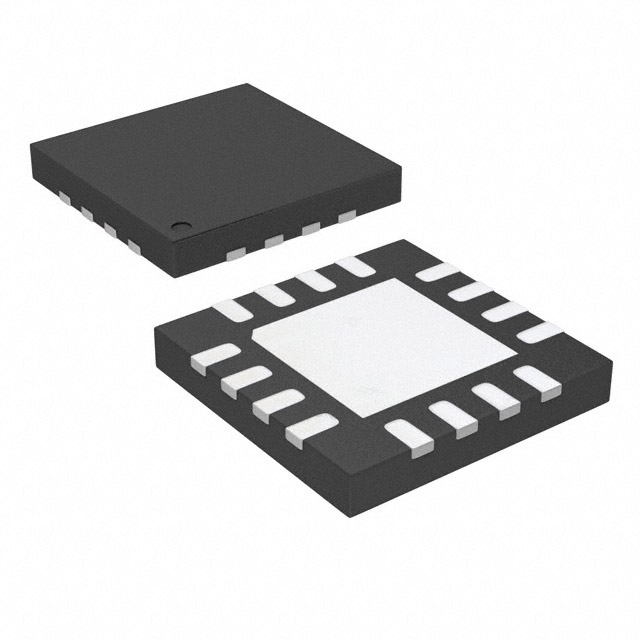Lihat spesifikasi untuk detail produk.

LTC2635CUD-LZ12#TRPBF
Product Overview
Category
The LTC2635CUD-LZ12#TRPBF belongs to the category of digital-to-analog converters (DACs).
Use
This product is primarily used in applications where precise analog voltage outputs are required. It converts digital signals into corresponding analog voltages.
Characteristics
- High precision: The LTC2635CUD-LZ12#TRPBF offers exceptional accuracy and resolution, ensuring reliable and precise analog voltage outputs.
- Low power consumption: This DAC is designed to operate with minimal power consumption, making it suitable for battery-powered devices and energy-efficient applications.
- Small package size: The LTC2635CUD-LZ12#TRPBF comes in a compact package, allowing for space-saving integration into various electronic systems.
- Wide operating voltage range: It can operate within a wide voltage range, providing flexibility in different power supply configurations.
Package and Quantity
The LTC2635CUD-LZ12#TRPBF is available in a small form factor 10-lead MSOP package. It is typically sold in reels, with a quantity of 2500 units per reel.
Specifications
- Resolution: 12 bits
- Number of channels: 1
- Output type: Voltage
- Output voltage range: 0V to VREF
- Reference voltage: Configurable, typically 2.5V
- Interface: SPI-compatible serial interface
- Operating temperature range: -40°C to +85°C
- Supply voltage range: 2.7V to 5.5V
- Integral nonlinearity (INL): ±1 LSB (max)
- Differential nonlinearity (DNL): ±1 LSB (max)
Pin Configuration
The LTC2635CUD-LZ12#TRPBF has the following pin configuration:
- VDD: Supply voltage
- GND: Ground
- SCK: Serial clock input
- SDI: Serial data input
- CS: Chip select input
- LDAC: Load DAC input
- REF: Reference voltage input
- AGND: Analog ground
- OUT: Analog output
- NC: No connection
Functional Features
- High accuracy: The LTC2635CUD-LZ12#TRPBF provides precise analog voltage outputs with a resolution of 12 bits, ensuring accurate signal generation.
- Fast settling time: This DAC offers fast settling time, enabling rapid response to changes in digital input signals.
- Low glitch energy: It minimizes glitches during transitions, resulting in smooth and stable analog outputs.
- Power-on reset to zero scale: Upon power-up, the DAC automatically resets to zero scale, preventing any unintended voltage outputs during initialization.
Advantages and Disadvantages
Advantages
- High precision and resolution
- Low power consumption
- Compact package size
- Wide operating voltage range
- Fast settling time
Disadvantages
- Limited number of channels (single-channel)
- Requires an external reference voltage source
Working Principles
The LTC2635CUD-LZ12#TRPBF operates based on the principle of digital-to-analog conversion. It receives digital input signals through the SPI-compatible serial interface. These digital signals are then processed internally to generate corresponding analog voltages at the output pin. The reference voltage input determines the maximum output voltage range. By adjusting the digital input values, the desired analog voltage can be obtained.
Detailed Application Field Plans
The LTC2635CUD-LZ12#TRPBF finds applications in various fields, including but not limited to: - Industrial automation: Precise analog voltage outputs are often required for controlling motors, valves, and other industrial equipment. - Test and measurement: This DAC can be used in test equipment to generate accurate analog signals for calibration and testing purposes. - Audio systems: It is suitable for audio applications where high-quality analog voltage outputs are necessary for audio signal processing and amplification. - Telecommunications: The LTC2635CUD-LZ12#TRPBF can be utilized in telecommunications equipment for generating precise analog voltages in signal conditioning circuits.
Detailed and Complete Alternative Models
- LTC2635CUD-LZ10#TRPBF: Similar to LTC2635CUD-LZ12#TRPBF but with a resolution of 10 bits.
- LTC2635CUD-LZ8#TRPBF: Similar to LTC2635CUD-LZ12#TRPBF but with a resolution of 8 bits.
- LTC2635CUD-LZ16#TRPBF: Similar to LTC2635CUD-LZ12#TRPBF but with a higher resolution of 16 bits.
These alternative models offer different resolutions to cater to specific application requirements.
In conclusion, the LTC
Sebutkan 10 pertanyaan dan jawaban umum terkait penerapan LTC2635CUD-LZ12#TRPBF dalam solusi teknis
Sure! Here are 10 common questions and answers related to the application of LTC2635CUD-LZ12#TRPBF in technical solutions:
Q: What is LTC2635CUD-LZ12#TRPBF? A: LTC2635CUD-LZ12#TRPBF is a digital-to-analog converter (DAC) manufactured by Linear Technology (now part of Analog Devices). It is used to convert digital signals into analog voltages.
Q: What is the resolution of LTC2635CUD-LZ12#TRPBF? A: The LTC2635CUD-LZ12#TRPBF has a resolution of 12 bits, meaning it can represent analog voltages with 4096 discrete levels.
Q: What is the supply voltage range for LTC2635CUD-LZ12#TRPBF? A: The supply voltage range for LTC2635CUD-LZ12#TRPBF is typically between 2.7V and 5.5V.
Q: How many channels does LTC2635CUD-LZ12#TRPBF have? A: LTC2635CUD-LZ12#TRPBF is a quad-channel DAC, which means it has four independent output channels.
Q: What is the output voltage range of LTC2635CUD-LZ12#TRPBF? A: The output voltage range of LTC2635CUD-LZ12#TRPBF is determined by the reference voltage applied to its VREF pin. It can be programmed to output any voltage within this range.
Q: Can LTC2635CUD-LZ12#TRPBF operate in both unipolar and bipolar modes? A: Yes, LTC2635CUD-LZ12#TRPBF can be configured to operate in both unipolar (0V to VREF) and bipolar (-VREF/2 to +VREF/2) modes.
Q: What is the settling time of LTC2635CUD-LZ12#TRPBF? A: The settling time of LTC2635CUD-LZ12#TRPBF is typically around 6μs, which refers to the time it takes for the output voltage to reach within a specified error band after a change in the digital input.
Q: Can LTC2635CUD-LZ12#TRPBF be controlled using an I2C interface? A: Yes, LTC2635CUD-LZ12#TRPBF supports I2C communication protocol, allowing it to be easily controlled by microcontrollers or other digital devices.
Q: Does LTC2635CUD-LZ12#TRPBF have any internal reference voltage? A: No, LTC2635CUD-LZ12#TRPBF does not have an internal reference voltage. An external reference voltage must be provided to accurately set the output voltage range.
Q: What are some typical applications of LTC2635CUD-LZ12#TRPBF? A: LTC2635CUD-LZ12#TRPBF is commonly used in various applications such as industrial automation, instrumentation, motor control, audio equipment, and communication systems where precise analog voltage generation is required.
Please note that the answers provided here are general and may vary depending on specific datasheet specifications and application requirements.

